Mastering Phonics and Phonemic Awareness: A Comprehensive Guide
 In the realm of early literacy, mastering phonics and phonemic awareness serves as the cornerstone for proficient reading and language acquisition. This comprehensive guide aims to demystify these fundamental components, providing educators, parents, and learners with valuable insights, strategies, and practical tips to foster a strong foundation in reading.
In the realm of early literacy, mastering phonics and phonemic awareness serves as the cornerstone for proficient reading and language acquisition. This comprehensive guide aims to demystify these fundamental components, providing educators, parents, and learners with valuable insights, strategies, and practical tips to foster a strong foundation in reading.
Understanding Phonics:
Phonics is the systematic relationship between sounds and their corresponding letters, playing a pivotal role in decoding words. It empowers learners to grasp the alphabetic principle, recognizing that letters represent specific sounds. By understanding phonics, readers enhance their ability to decode unfamiliar words and improve spelling skills.
Phonics vs. Whole Language Approach:
While phonics emphasizes the direct teaching of letter-sound relationships, the whole language approach focuses on contextual learning through exposure to complete words and sentences. Striking a balance between these methodologies ensures a comprehensive and effective reading instruction.
The Alphabetic Principle:
Central to phonics instruction is the alphabetic principle, where learners understand that written words are composed of letters that represent sounds. This principle lays the groundwork for decoding and spelling, fostering a deeper connection between letters and their corresponding sounds.
Phonemic Awareness Demystified:
Phonemic awareness is the ability to recognize and manipulate individual sounds, or phonemes, within spoken words. Unlike phonics, which involves the connection between letters and sounds, phonemic awareness is purely auditory. It's a critical skill that enables learners to decode and spell words accurately.
The Role of Phonemic Awareness in Reading:
Phonemic awareness plays a pivotal role in decoding and spelling. When learners can identify and manipulate individual phonemes, they develop a strong foundation for recognizing word patterns, improving reading fluency, and becoming proficient readers.
Phonemic Awareness Activities:
Engaging activities are key to developing phonemic awareness. From rhyming games to segmenting and blending sounds, these activities help learners grasp the subtleties of individual phonemes. Interactive and enjoyable exercises make the learning process more accessible for young readers.
Strategies for Effective Instruction:
Integrating phonics and phonemic awareness ensures a balanced approach to reading instruction. Employing classroom activities and games that make learning enjoyable enhances engagement. Tailoring instruction to support struggling readers allows for personalized learning experiences, addressing diverse needs.
Resources and Tools:
Various phonics programs offer systematic instruction, reinforcing the connection between letters and sounds. Online tools and apps provide interactive platforms for learners to practice phonics and phonemic awareness skills in a digital format, catering to diverse learning styles.
Conclusion:
Mastering phonics and phonemic awareness is the gateway to unlocking the world of reading. By understanding the alphabetic principle, embracing phonemic awareness, and employing effective instructional strategies, educators and parents can empower learners to become confident and proficient readers. With a solid foundation in place, the journey to literacy becomes an exciting adventure filled with discovery and understanding.

 Phonics refers to the systematic instruction of the relationship between sounds and the letters or groups of letters that represent them. It involves teaching children how to connect individual sounds (phonemes) with specific letters or letter combinations (graphemes). Phonics instruction helps children understand the correspondence between spoken and written language, enabling them to decode words and read fluently.
Phonics refers to the systematic instruction of the relationship between sounds and the letters or groups of letters that represent them. It involves teaching children how to connect individual sounds (phonemes) with specific letters or letter combinations (graphemes). Phonics instruction helps children understand the correspondence between spoken and written language, enabling them to decode words and read fluently.